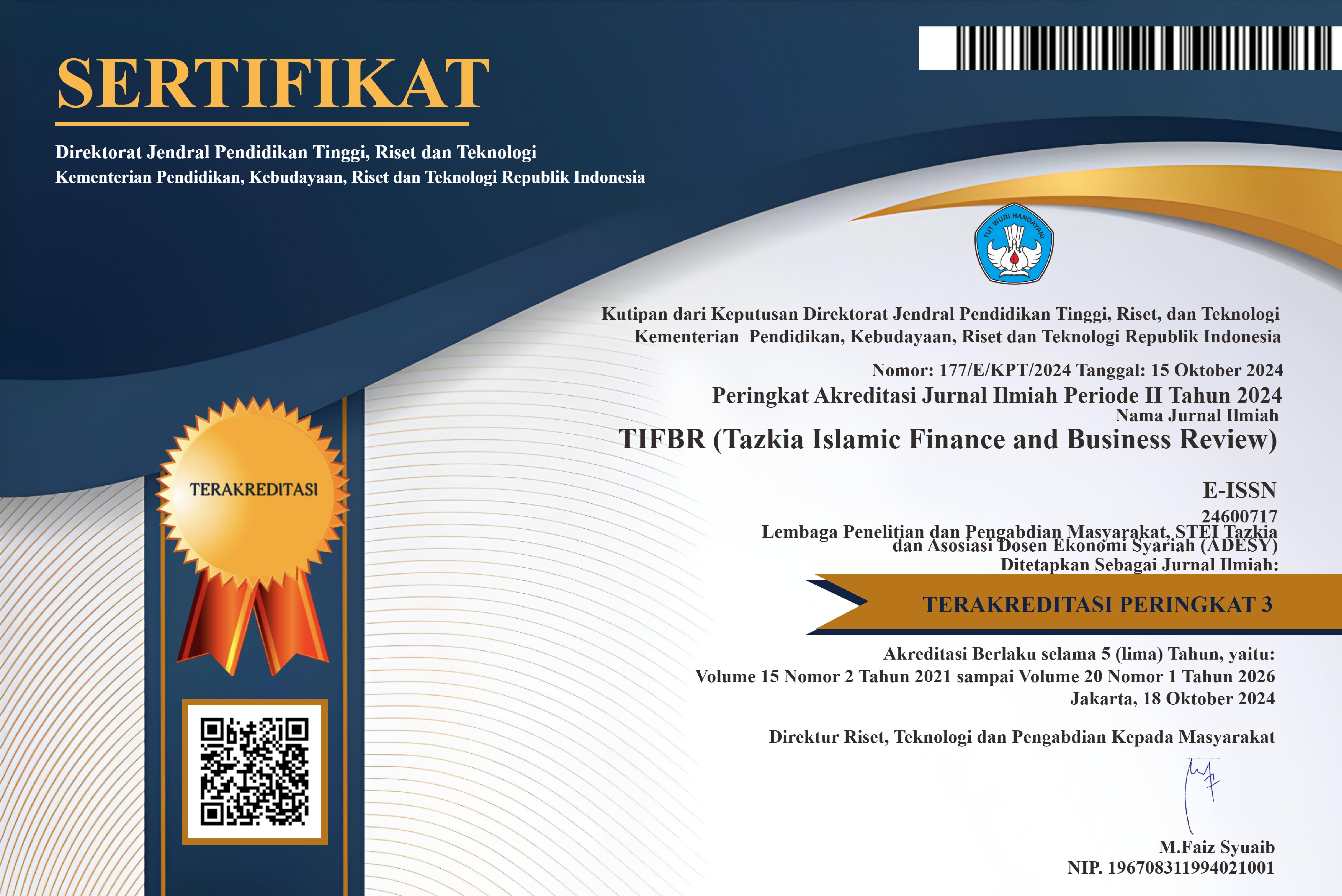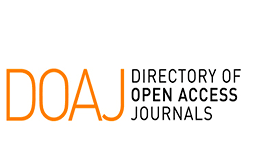Halal Purchase Intention on Processed Food
DOI:
https://doi.org/10.30993/tifbr.v11i2.142Keywords:
halal food, purchase intention, SEMAbstract
The objective of this study is to investigate the factors affecting customers on purchasing halal purchase intention on processed food. A purposive sampling method with 193 respondents and the data analysis is done by SEM-PLS method. The results show that halal awareness, health reason, and perceived value have a significant and positive direct effect on purchasing intention. Halal marketing also shows a significant and positive effect on purchasing intention. The food safety, halal certification, brand image, and perceived quality show the same effect which has no direct effect on purchasing intention. Furthermore, Food safety has an indirect effect on purchasing intention through health reason. Halal certification has an indirect effect on purchase intention through brand image variable. Meanwhile, brand image and perceived quality have an indirect effect through perceived value variable on purchasing intention.References
Ahmad, M.F. (2014). Antecedents of Halal Brand Personality. Journal of Islamic Marketing, Vol. 6(2): 209-223.
Al-Ghazali, I. (2007). Rahasia Halal-Haram: Hakikat Batin Perintah dan Larangan Allah. Bandung (ID): Mizan Media Utama.
Al-Qur’an dan Terjemahannya. (2008). Jakarta: CV Penerbit Diponogoro.
Ambali, A.R. and Bakar, A.N. (2013). Ḥalāl Food and Products in Malaysia: People’s Awareness and Policy Implications. IIUM Press Intellectual Discourse, Vol. 21(1): 7-32.
Apriyantono, Anton. (2005). Makanan dan Minuman Halal. Bandung (ID): Kiblat Buku Utama.
Apriyantono, A. Hermanianto, J. and Wahid N. (2007). Pedoman Produksi Pangan Halal. Jakarta (ID): Khairul Bayan Press.
Asyraf, W. M. (2013). A Comparison of Partial Least Square Structural Equation Modeling (PLS-SEM) and Covariance Based Structural Equation Modeling (CB-SEM) for Confirmatory Factor Analysis. International Journal of Engineering Science and Innovative Technology (IJESIT), Vol. 2.
Awan, H.M. Siddiquei, A.N. and Haider, Z. (2015). Factors Affecting Halal Purchase Intention – Evidence From Pakistan’s Halal Food Sector. Management Research Review, Vol. 38(6).
Aziz, Y.A. and Chok, N.V. (2013). The Role of Halal Awareness, Halal Certification, and Marketing Components in Determining Halal Purchase Intention Among Non-Muslims in Malaysia: A Structural Equation Modeling Approach. Journal of International Food & Agribusiness Marketing, Vol. 25(1): 23.
Badan Pusat Statistik. (2010). Penduduk Menurut Wilayah dan Agama yang Dianut.
Retrieved from: http://sp2010.bps.go.id/index.php/site/tabel?tid=321.
Borzooei, M. and Asgari, M. (2013). The Halal Brand Personality and Its
Effect on Purchase Intention. Interdisciplinary Journal of Contemporary Research in Business, Vol. 5(3)
Burhanuddin. (2011). Pemikiran Hukum Perlindungan Konsumen dan Halal Certification. Malang (ID): UIN-MALIKI Press.
Feuss, W.J. (2003). The Post-Purchase Impact of Brand Image. [Disertasi]. Hoboken: Stevens Institute of Technology.
Ghazali, I. (2008). Structural Equation Modeling Metode Alternatif dengan Partial Least Square. Semarang: Badan Penerbit Universitas Diponogoro.
Ghozali, I. and Latan, H. (2015). Partial Least Square Konsep, Tekni, dan Aplikasi Menggunakan SmartPLS 3.0. Semarang: Badan Penerbit Universitas Diponogoro.
Hair, J.F. Ringle, C.M. and Sarstedt, M. (2011). PLS-SEM: Indeed a Silver Bullet. Journal of Marketing Theory and Practice, Vol. 19(2), 139–15.
Hamdan, H. et al. (2013). Purchasing Decisions among Muslim Consumers of Processed Halal Food Products. Journal of Food Products Marketing, Vol. 19: 54–61.
Hussain, I. et al. (2016). Integrating Factors Influencing Consumers’ Halal Products Purchase: Application of Theory of Reasoned Action. Journal of International Food & Agribusiness Marketing.
Issa, Z.M. et al. (2009). Practices of Food Producers in Producing Halal Food. Interdisciplinary Journal of Conpemporary Research in Business, Vol. 1(7).
Kotler, P. and Keller, K.L. (2009). Manajemen Pemasaran Edisi 13 Jilid 1. Jakarta (ID): Penerbit Erlangga.
Kusnendi. (2008). Model-Model Persamaan Struktural. Bandung (ID): Alfabeta.
Lada, S. Tanakinjal, G.H. and Amin, H. (2009). Predicting Intention to Choose Halal Products Using Theory of Reasoned Action. International Journal of Islamic and Middle Eastern Finance and Management, Vol. 2(1).
Latan, H. (2013). Struktural Equation Modeling: Konsep dan Aplikasi menggunakan Program LISREL 8.80. Bandung (ID): Penerbit Alfabeta.
Lee, H.M. Lee, C.C. and Wu, C.C. (2011). Brand Image Strategy Affects Brand Equity After M&A. European Journal of Marketing, Vol. 45(7/8).
LPPOM MUI. (2008). Persyaratan Halal Certification. Retrieved from: http://www.halalmui.org/newMUI/index.php/main/go_to_section/39/1328/page/1.
Marketeers Editor. (2012). Pasar Halal Dunia Capai USD 2,3 Triliun. Retrieved from: http://marketeers.com/pasar-halal-dunia-capai-usd-23-triliun/
Mulyono, D. (2016). Pengaruh Media Sosial Terhadap Keputusan Memberikan Donasi pada Rumah Zakat [Tesis]. Bogor (ID): Institut Pertanian Bogor.
Qaradhawi, Y. (2013). Halal dan Haram. Bandung (ID): Penerbit Jabal.
Rajagopal, S. (2011). Halal Certification: Implication for Marketers in UAE. Journal of Islamic Marketing, Vol. 2(2).
Saifullah, R. (2008). Studi Kebijakan Pangan Halal di Indonesia [Skripsi]. Bogor (ID): Institut Pertanian Bogor.
Salehudin, I. Mukhlish, B.M. (2012). Pemasaran Halal: Konsep, Implikasi dan Temuan di Lapangan. Kumpulan Tulisan Ekonom Muda FEUI: 293-305. Jakarta (ID): Lembaga Penerbit Fakultas Ekonomi UI.
Santoso, D. (2016). Faktor-Faktor yang Mempengaruhi Minat Beli padaPrivate Label Foods [Tesis]. Bogor (ID): Institut Pertanian Bogor.
Senthilnathan, S. and Tharmi, U. (2012). The Relationship of Brand Equity to Purchase Intention. The IUP Journal of Marketing Management, Vol. 11(2).
Syahruddin. (2014). Potensi Kemajuan Umat Melalui Produk Halal. Retrieved from: http://majalahgontor.net/potensi-kemajuan-umat-melalui-produk-halal/.
Tieman, M. and Ghazali, MC. (2013). Principles in Halal Purchasing. Journal of Islamic Marketing, Vol. 4(3): 281-293.
Wang, EST. (2015). Effect of Food Service-Brand quity on Consumer-Perceived Food Value, Physical Risk, and Brand Preference. British Food Journal, Vol. 117(2).
Wang, Y.H. and Tsai, C.F. (2014). The Relationship Between Brand Image and Purchase Intention: Evidence from Award Winning Mutual Funds. The International Journal of Business and Finance Research, Vol. 8(2).
Wu Paul, C.S. Yeh, G.Y. Hsiao, C. (2011). The Effect of Store Image And Service Quality on Brand Image and Purchase Intention for Private Label Brands. Australian Marketing Journal, Vol. 19: 30–39.
Al-Ghazali, I. (2007). Rahasia Halal-Haram: Hakikat Batin Perintah dan Larangan Allah. Bandung (ID): Mizan Media Utama.
Al-Qur’an dan Terjemahannya. (2008). Jakarta: CV Penerbit Diponogoro.
Ambali, A.R. and Bakar, A.N. (2013). Ḥalāl Food and Products in Malaysia: People’s Awareness and Policy Implications. IIUM Press Intellectual Discourse, Vol. 21(1): 7-32.
Apriyantono, Anton. (2005). Makanan dan Minuman Halal. Bandung (ID): Kiblat Buku Utama.
Apriyantono, A. Hermanianto, J. and Wahid N. (2007). Pedoman Produksi Pangan Halal. Jakarta (ID): Khairul Bayan Press.
Asyraf, W. M. (2013). A Comparison of Partial Least Square Structural Equation Modeling (PLS-SEM) and Covariance Based Structural Equation Modeling (CB-SEM) for Confirmatory Factor Analysis. International Journal of Engineering Science and Innovative Technology (IJESIT), Vol. 2.
Awan, H.M. Siddiquei, A.N. and Haider, Z. (2015). Factors Affecting Halal Purchase Intention – Evidence From Pakistan’s Halal Food Sector. Management Research Review, Vol. 38(6).
Aziz, Y.A. and Chok, N.V. (2013). The Role of Halal Awareness, Halal Certification, and Marketing Components in Determining Halal Purchase Intention Among Non-Muslims in Malaysia: A Structural Equation Modeling Approach. Journal of International Food & Agribusiness Marketing, Vol. 25(1): 23.
Badan Pusat Statistik. (2010). Penduduk Menurut Wilayah dan Agama yang Dianut.
Retrieved from: http://sp2010.bps.go.id/index.php/site/tabel?tid=321.
Borzooei, M. and Asgari, M. (2013). The Halal Brand Personality and Its
Effect on Purchase Intention. Interdisciplinary Journal of Contemporary Research in Business, Vol. 5(3)
Burhanuddin. (2011). Pemikiran Hukum Perlindungan Konsumen dan Halal Certification. Malang (ID): UIN-MALIKI Press.
Feuss, W.J. (2003). The Post-Purchase Impact of Brand Image. [Disertasi]. Hoboken: Stevens Institute of Technology.
Ghazali, I. (2008). Structural Equation Modeling Metode Alternatif dengan Partial Least Square. Semarang: Badan Penerbit Universitas Diponogoro.
Ghozali, I. and Latan, H. (2015). Partial Least Square Konsep, Tekni, dan Aplikasi Menggunakan SmartPLS 3.0. Semarang: Badan Penerbit Universitas Diponogoro.
Hair, J.F. Ringle, C.M. and Sarstedt, M. (2011). PLS-SEM: Indeed a Silver Bullet. Journal of Marketing Theory and Practice, Vol. 19(2), 139–15.
Hamdan, H. et al. (2013). Purchasing Decisions among Muslim Consumers of Processed Halal Food Products. Journal of Food Products Marketing, Vol. 19: 54–61.
Hussain, I. et al. (2016). Integrating Factors Influencing Consumers’ Halal Products Purchase: Application of Theory of Reasoned Action. Journal of International Food & Agribusiness Marketing.
Issa, Z.M. et al. (2009). Practices of Food Producers in Producing Halal Food. Interdisciplinary Journal of Conpemporary Research in Business, Vol. 1(7).
Kotler, P. and Keller, K.L. (2009). Manajemen Pemasaran Edisi 13 Jilid 1. Jakarta (ID): Penerbit Erlangga.
Kusnendi. (2008). Model-Model Persamaan Struktural. Bandung (ID): Alfabeta.
Lada, S. Tanakinjal, G.H. and Amin, H. (2009). Predicting Intention to Choose Halal Products Using Theory of Reasoned Action. International Journal of Islamic and Middle Eastern Finance and Management, Vol. 2(1).
Latan, H. (2013). Struktural Equation Modeling: Konsep dan Aplikasi menggunakan Program LISREL 8.80. Bandung (ID): Penerbit Alfabeta.
Lee, H.M. Lee, C.C. and Wu, C.C. (2011). Brand Image Strategy Affects Brand Equity After M&A. European Journal of Marketing, Vol. 45(7/8).
LPPOM MUI. (2008). Persyaratan Halal Certification. Retrieved from: http://www.halalmui.org/newMUI/index.php/main/go_to_section/39/1328/page/1.
Marketeers Editor. (2012). Pasar Halal Dunia Capai USD 2,3 Triliun. Retrieved from: http://marketeers.com/pasar-halal-dunia-capai-usd-23-triliun/
Mulyono, D. (2016). Pengaruh Media Sosial Terhadap Keputusan Memberikan Donasi pada Rumah Zakat [Tesis]. Bogor (ID): Institut Pertanian Bogor.
Qaradhawi, Y. (2013). Halal dan Haram. Bandung (ID): Penerbit Jabal.
Rajagopal, S. (2011). Halal Certification: Implication for Marketers in UAE. Journal of Islamic Marketing, Vol. 2(2).
Saifullah, R. (2008). Studi Kebijakan Pangan Halal di Indonesia [Skripsi]. Bogor (ID): Institut Pertanian Bogor.
Salehudin, I. Mukhlish, B.M. (2012). Pemasaran Halal: Konsep, Implikasi dan Temuan di Lapangan. Kumpulan Tulisan Ekonom Muda FEUI: 293-305. Jakarta (ID): Lembaga Penerbit Fakultas Ekonomi UI.
Santoso, D. (2016). Faktor-Faktor yang Mempengaruhi Minat Beli padaPrivate Label Foods [Tesis]. Bogor (ID): Institut Pertanian Bogor.
Senthilnathan, S. and Tharmi, U. (2012). The Relationship of Brand Equity to Purchase Intention. The IUP Journal of Marketing Management, Vol. 11(2).
Syahruddin. (2014). Potensi Kemajuan Umat Melalui Produk Halal. Retrieved from: http://majalahgontor.net/potensi-kemajuan-umat-melalui-produk-halal/.
Tieman, M. and Ghazali, MC. (2013). Principles in Halal Purchasing. Journal of Islamic Marketing, Vol. 4(3): 281-293.
Wang, EST. (2015). Effect of Food Service-Brand quity on Consumer-Perceived Food Value, Physical Risk, and Brand Preference. British Food Journal, Vol. 117(2).
Wang, Y.H. and Tsai, C.F. (2014). The Relationship Between Brand Image and Purchase Intention: Evidence from Award Winning Mutual Funds. The International Journal of Business and Finance Research, Vol. 8(2).
Wu Paul, C.S. Yeh, G.Y. Hsiao, C. (2011). The Effect of Store Image And Service Quality on Brand Image and Purchase Intention for Private Label Brands. Australian Marketing Journal, Vol. 19: 30–39.
Downloads
Published
2018-06-05
How to Cite
Nurhasanah, S., & Hariyani, H. F. (2018). Halal Purchase Intention on Processed Food. Tazkia Islamic Finance and Business Review, 11(2). https://doi.org/10.30993/tifbr.v11i2.142
Issue
Section
Articles
License

Tazkia Islamic Finance and Business Review (TIFBR) is licensed under a Creative Commons Attribution-NonCommercial 4.0 International License.
Authors who publish with this journal agree to the following terms:
- Authors retain copyright and grant the journal right of first publication with the work simultaneously licensed under a Creative Commons Attribution License that allows others to share the work with an acknowledgment of the work's authorship and initial publication in this journal.
- Authors are able to enter into separate, additional contractual arrangements for the non-exclusive distribution of the journal's published version of the work (e.g., post it to an institutional repository or publish it in a book), with an acknowledgment of its initial publication in this journal.
- Authors are permitted and encouraged to post their work online (e.g., in institutional repositories or on their website), as it can lead to productive exchanges, as well as earlier and greater citation of published work (See the Effect of Open Access).
















